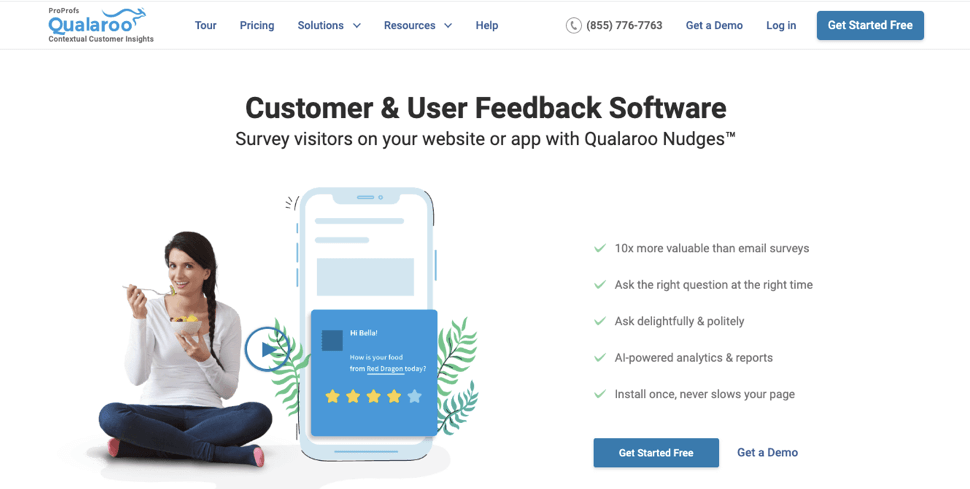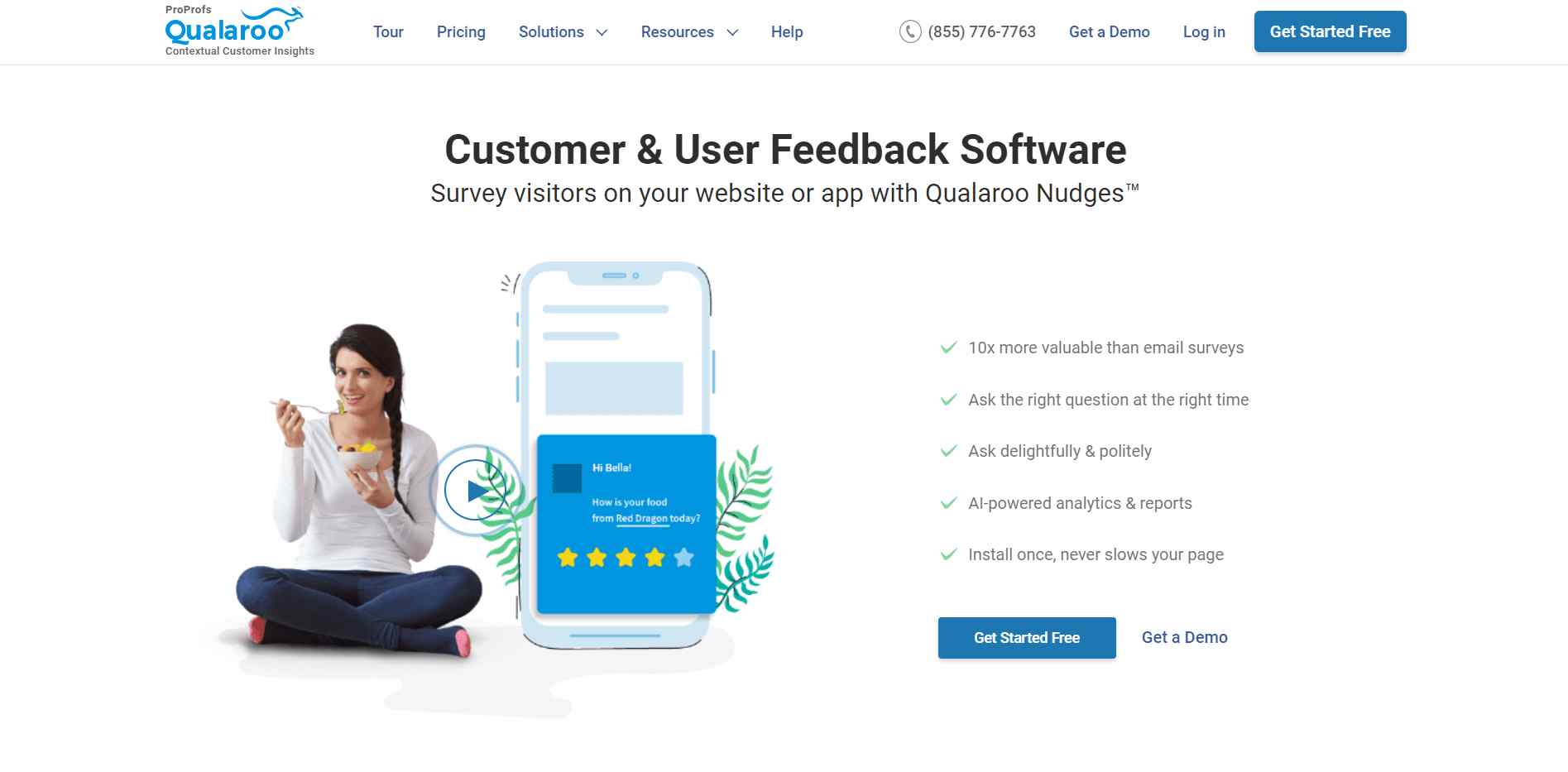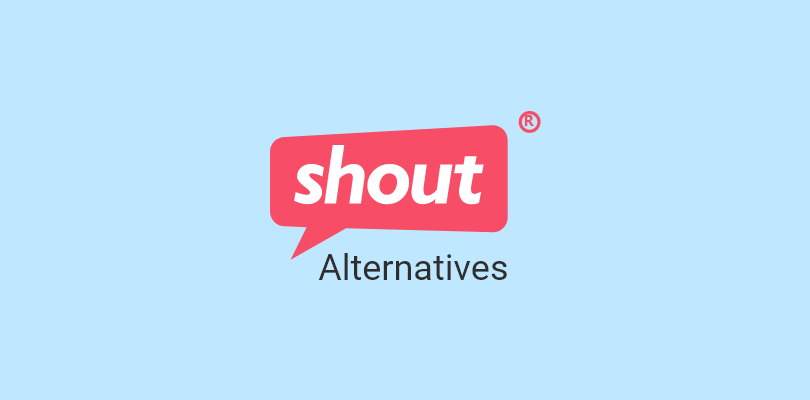As a marketer, I understand the importance of customer feedback and insights. While Hotjar is a familiar name in the world of user feedback, there are Hotjar survey alternatives that can take your customer experience and conversion strategy to the next level in 2025 .
In this article, I’ll share the 7 best Hotjar Survey alternatives that’ll help you gather user feedback and insights like never before. Whether you need cost-effective solutions or feature-rich tools, I’ve got you covered.So, let’s explore the best Hotjar alternatives that can revolutionize your customer experience and maximize conversions.
Top Hotjar Survey Alternatives
Here are 7 tools that are comparable to Hotjar but, in my opinion, fare better when it comes to gathering valuable user insights through surveys:
1. Qualaroo – Best for Contextual User Feedback
Qualaroo is excellent for getting real-time feedback from website visitors. Its NudgeTM technology asks the right questions at the right time without bothering users.
With the conditional logic, I could set up survey flows to collect qualitative and quantitative insights.
This Hotjar survey alternative uses metrics like Net Promoter Score (NPS), Customer Satisfaction Score (CSAT), and Customer Effort Score (CES) to measure customer satisfaction and loyalty.
Thanks to Qualaroo, I improved my website and app, increased conversions, collected invaluable product feedback, and ultimately reduced customer churn.
I could also leverage Qualaroo’s AI-driven sentiment analysis to effortlessly extract valuable insights from open-text feedback.
What you’ll like
- Enjoy the benefit of advanced targeting, allowing you to present surveys to specific individuals at optimal moments.
- Utilize the sidebar survey widget, empowering your customers to share feedback conveniently.
- Implement surveys across websites, products, prototypes, and mobile apps.
- Seamlessly connect with tools such as Salesforce, Hootsuite, and Slack for organized data management.
- Enhance your understanding of potential buyers through exit surveys, boosting conversion rates.
- Automatically calculate and display Net Promoter Score (NPS).
What you may not like:
- Additional templates tailored to specific industries would be beneficial.
- Including options to export data in various formats could enhance the overall user experience.
Pricing: Qualaroo offers a forever free plan for startups and small businesses with all premium features. Paid starts at $19.99/month.
2. Crazy Egg – Best for Website Optimization
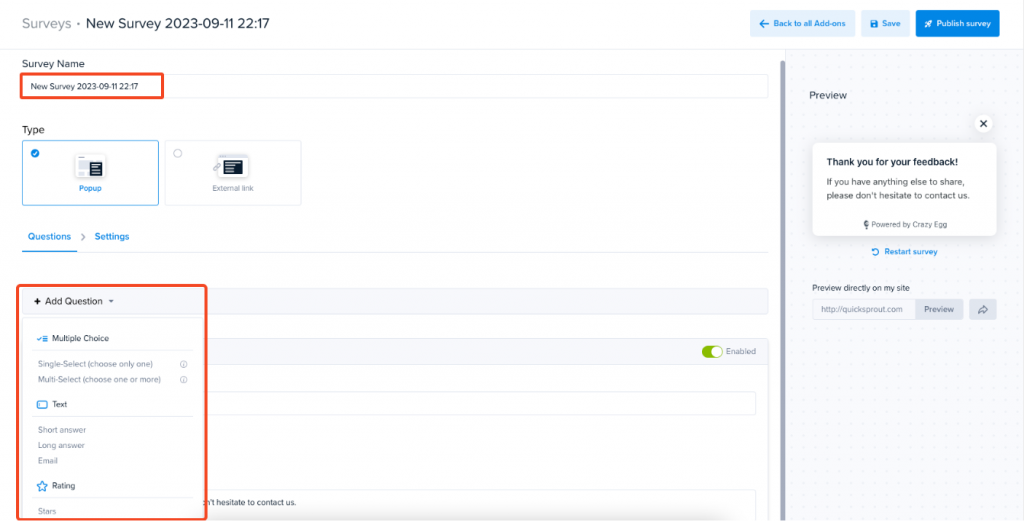
Crazy Egg offers a range of tools to help you gain valuable insights into your website visitors’ behaviors. You can understand how users interact with your site through heatmaps, recordings, surveys, and A/B testing.
By using Crazy Egg, I could optimize my web design, increase conversions, and reduce bounce rates. The platform seamlessly integrates with popular services like Shopify, WordPress, and Google Analytics and allows you to add unlimited team members at no additional cost.
With this Hotjar survey alternative, I also found it easy to drill down into the behavior of visitors from email and ad campaigns, gain insights behind pop-up forms or login screens, and set up successful website or page redesign projects.
What you’ll like:
- Provides detailed visual information on website performance with the use of heatmaps, scroll maps, and tracking.
- Highly effective A/B testing tool, allowing for testing different website layouts or user modules.
- Offers granular analytics to understand user performance data effectively and increase engagement. It provides insights such as click-through rates, time spent on pages, and scroll depth.
- Provides a variety of tools that assist in both web design and optimization. These tools include overlays, confetti reports, and user session recordings.
What you may not like:
- The user interface can be complex and challenging to navigate, especially for newcomers.
- Setting up and interpreting A/B tests may require some technical knowledge and experimentation.
- Analyzing data and tracking user behavior on websites with numerous pages can be time-intensive.
3. Survicate – Best for Multi-Channel Surveys
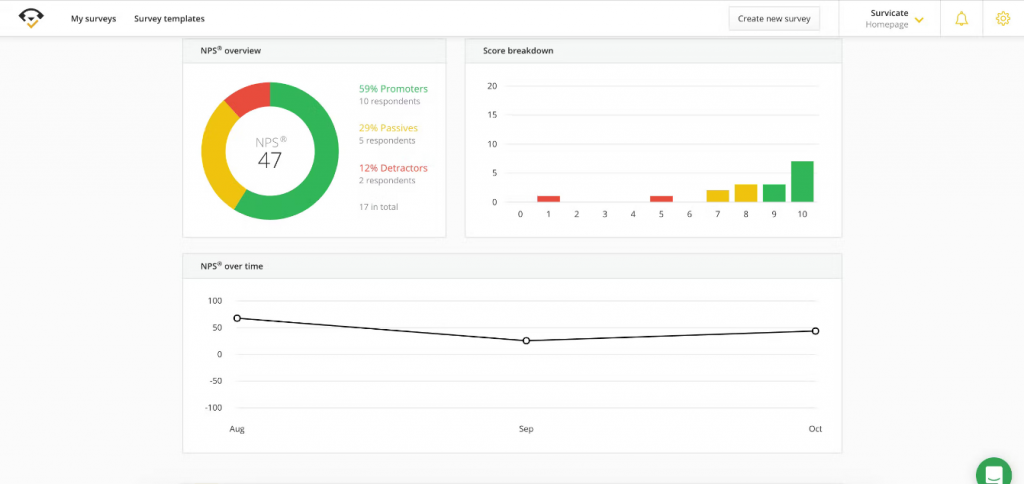
Survicate is a versatile survey tool that enables you to gather feedback from users across various channels, including in-product, website, email, and mobile apps.
With Survicate, you can measure customer satisfaction, conduct user research, carry out product research, and drive growth marketing initiatives.
I found it easy to create surveys with Survicate’s drag-and-drop functionality. I could create highly customized surveys and set up advanced targeting.
This Hotjar survey alternative allows you to capture survey responses even if the survey is partially completed. You can also automatically enrich surveys with user attributes, conduct multilingual surveys, and present surveys when users are most likely to respond.
What you’ll like:
- Advanced targeting that includes traffic segmentation and geolocation to reach highly targeted audiences.
- Seamless integrations with 30+ popular tools, such as Salesforce, HubSpot, and Slack.
- Intuitive dashboard with survey results and analytics, with filtering and exporting options.
- Conversational chat-like interface on surveys that has been shown to increase response rates.
What you may not like:
- Limited survey template adjustments available. While Survicate provides pre-designed survey templates, customization options are limited.
- Survey templates provided by Survicate could benefit from more modern designs and styles.
4. Refiner – Best for In-Product Micro-surveys
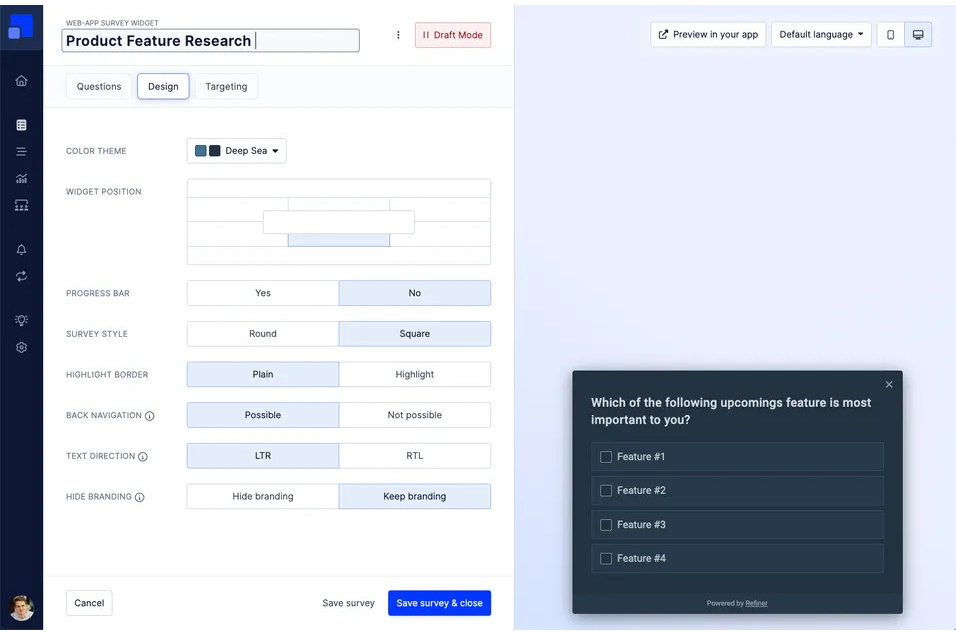
Refiner is a specialized survey tool designed for in-product micro-surveys on web and mobile applications.
Using Refiner, you can effectively segment your users, collect feedback, and improve user retention.
The platform supports all common survey use cases, including NPS, CSAT, CES, and feature research. It seamlessly integrates with Segment, Zapier, and other data platforms, providing valuable product and growth insights.
With this Hotjar survey alternative, I could launch perfectly timed surveys within my application, distribute surveys via email or personalized survey links, and sync survey results with my data warehouse.
What you’ll like:
- Offers in-product micro-surveys that can be targeted based on user behavior, segmentation, and retention efforts.
- Provides an intuitive and user-friendly interface for easy survey creation, editing, and deployment.
- Offers options for distributing surveys via email or personalized survey links. This flexibility lets you choose the most suitable method for reaching your target audience.
- Offers easy-to-understand analytics and visualizations that provide actionable insights.
What you may not like:
- Refiner doesn’t offer built-in support for multilingual surveys. If you need to conduct surveys in multiple languages, you need to use external translation services.
- Limited targeting capabilities might restrict the granularity of your survey campaigns.
5. Qualtrics – Best for Customer Experience Management
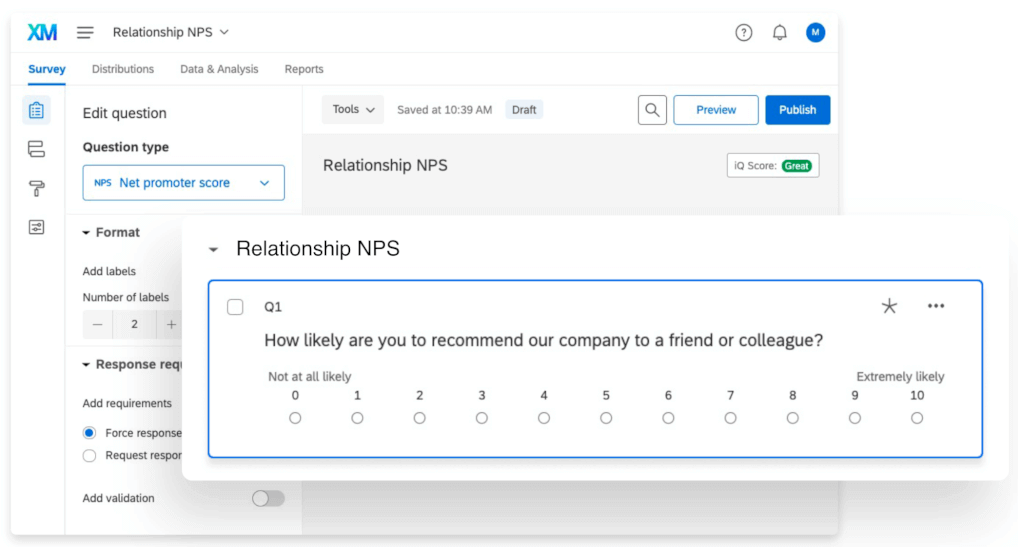
I got interested in Qualtrics as an alternative to Hotjar because of its comprehensive Experience Management (XM) platform.
Instead of just collecting feedback, this Hotjar survey alternative goes deeper into the whole user experience. It comes with advanced features like predictive intelligence, automated statistical testing, cluster analysis, sentiment tracking, proactive alerts, and data model creation—all part of its XM suite.
These features combined allowed me to predict customer needs, analyze and share results effectively, discover hidden patterns and trends, and design/test complex ideas.
Qualtrics also excels in smoothly integrating feedback across different organizational departments, providing a complete picture.
What you’ll like:
- Utilize 30 diverse graphs to visually depict survey findings.
- Employ predictive intelligence for a thorough examination of data reports.
- Enhance the overall customer experience by involving them with interactive multimedia content.
- Customize surveys extensively to align with your brand identity.
- Effortlessly integrate Qualtrics with various business tools, such as Canvs, Thematic, Segment, etc., to enhance insights and actions.
What you won’t like:
- The setup process initially demands a significant amount of time.
- The pricing may be higher, especially for smaller businesses.
- Users who are beginners may find the platform’s extensive features overwhelming.
Pricing: Plans start at $1,500/year (estimated pricing). Visit Qualtrics for a custom quote.
6. Pendo – Best for Launching Targeted In-App Surveys
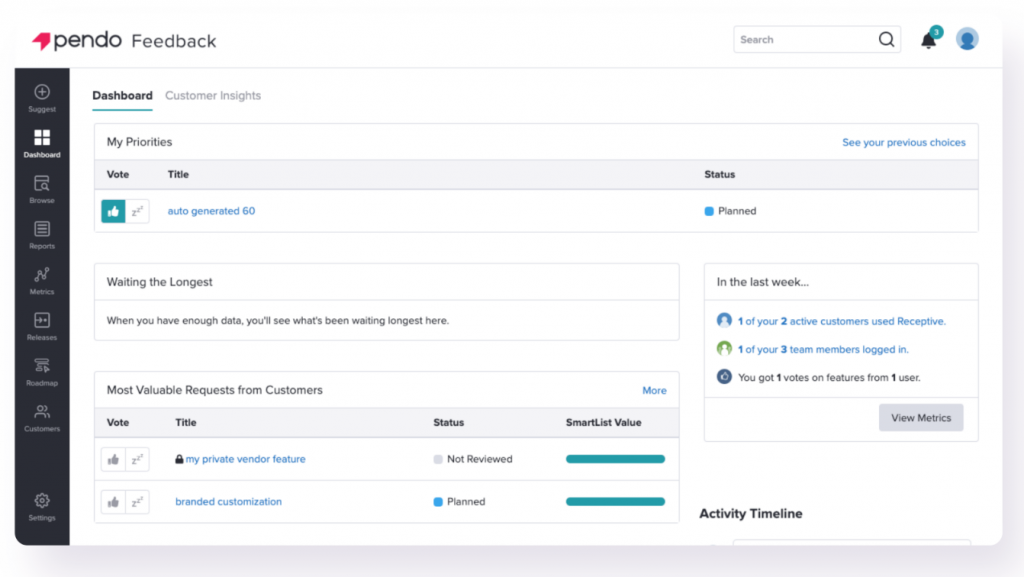
Image Source: Pendo
I often turned to Pendo to connect with my users and gather their thoughts. It was a valuable tool in grasping what my users wanted and figuring out ways to enhance their experience within the app.
Using this Hotjar alternative, I could personalize the user experience based on user behavior and their feedback on my product.
It allowed me to target my surveys for each user segment, enabling me to tailor the questions, design, timing, and frequency for better communication and engagement. This approach resulted in more responses and deeper insights from my audience.
Moreover, Pendo’s robust analytics capabilities provide a comprehensive understanding of user interactions within the app, making it an excellent choice for conducting in-app surveys.
What you’ll like:
- Seamless integration with widely-used CRMs such as HubSpot for automating workflows.
- Extensive customization options to glean tailored insights for diverse customer segments.
- Quantitative analytics enabling well-informed decision-making backed by actual metrics.
- Session replays for in-depth analysis of user interactions within applications.
- In-app guidance for a smooth onboarding experience.
What you won’t like:
- Pricing lacks transparency.
- The limited availability of UI patterns poses challenges in designing an optimal user experience.
Pricing: Custom pricing.
7. Userpilot – Best for Multilingual User Feedback Surveys
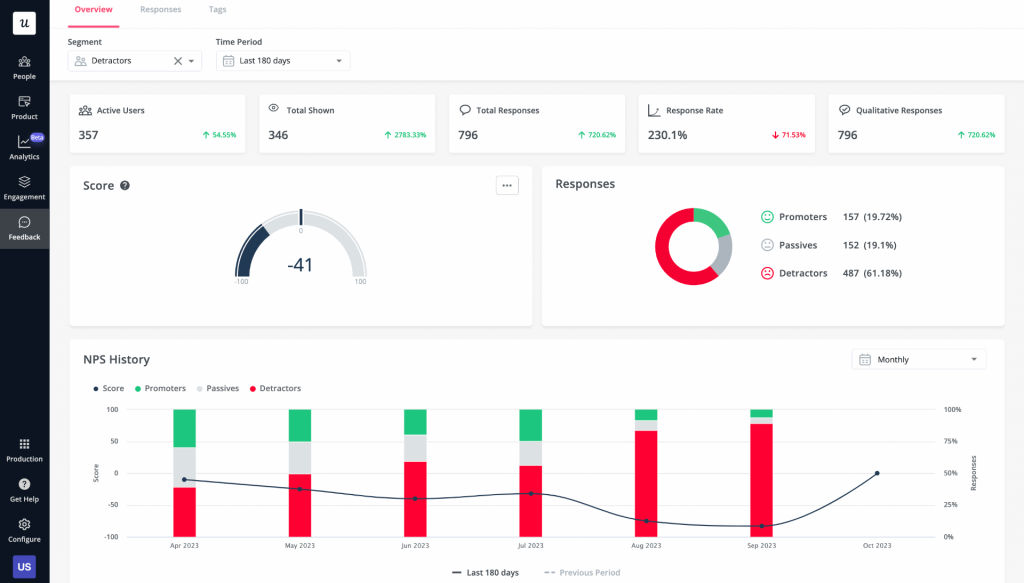
While exploring tools for gathering user feedback, I discovered Userpilot, a strong Hotjar competitor, which I added to my list.
What intrigued me the most about Userpilot was its ability to instantly translate language, making it easy to collect insights from a global audience.
With advanced AI, this Hotjar survey alternative can smoothly translate surveys into more than 100 languages.
Userpilot stands out from other tools because of its flexibility, allowing direct on-screen edits of translations to ensure the message is accurately conveyed in every language.
It also automatically detects a user’s browser language to present surveys in the user’s preferred language, enhancing the overall user experience and increasing response rates.
What you’ll like:
- Gain valuable strategic insights for targeting users subscribed to specific campaigns.
- Prioritize and organize surveys efficiently with the survey ordering feature.
- Customize surveys flexibly to match specific user attributes.
- Utilize effective surveys to assess various customer satisfaction metrics.
- Benefit from three survey triggers: Page Specific, Event Occurrence, and Manual.
What you won’t like:
- Limited integrations with other tools.
- The analytics doesn’t provide detailed information.
Pricing: Starts at $249/month.
Evaluation & Selection Criteria
The evaluation of products or tools chosen for this article follows an unbiased, systematic approach that ensures a fair, insightful, and well-rounded review. This method employs six key factors:
- User Reviews / Ratings: Direct experiences from users, including ratings and feedback from reputable sites, provide a ground-level perspective. This feedback is critical in understanding overall satisfaction and potential problems.
- Essential Features & Functionality: The value of a product is ascertained by its core features and overall functionality. Through an in-depth exploration of these aspects, the practical usefulness and effectiveness of the tools are carefully evaluated.
- Ease of Use: The user-friendliness of a product or service is assessed, focusing on the design, interface, and navigation. This ensures a positive experience for users of all levels of expertise.
- Customer Support: The quality of customer support is examined, taking into account its efficiency and how well it supports users in different phases – setting up, addressing concerns, and resolving operational issues.
- Value for Money: Value for money is evaluated by comparing the quality, performance, and features. The goal is to help the reader understand whether they would be getting their money’s worth.
- Personal Experience/Expert’s Opinion or Favorites: This part of the evaluation criteria draws insightful observations from the writer’s personal experience and the opinions of industry experts.
Which Is the Best Hotjar Survey Alternative?
Choosing the appropriate survey software can be daunting, given the plethora of options in today’s market.
I have condensed my top alternatives to Hotjar surveys to simplify your decision-making process to three exceptional choices. Below, you’ll find a brief overview of their strengths.
1. Qualaroo
Qualaroo shines as an outstanding Hotjar alternative, particularly for real-time feedback from website visitors. Leveraging NudgeTM technology, it tactfully extracts insights into customer motivations without disrupting the user experience.
Qualaroo provides a comprehensive solution for measuring customer satisfaction and understanding user emotions with features like conditional logic and AI-driven sentiment analysis.
2. Survicate
For those seeking versatile multi-channel surveys, Survicate stands out as an ideal alternative. Its intuitive drag-and-drop functionality allows for the creation of highly customized surveys complemented by advanced targeting options.
Survicate captures survey responses across various touchpoints, providing an intuitive dashboard and seamless integrations for a comprehensive surveying experience.
3. Refiner
Specializing in in-product microsurveys, Refiner offers a tailored alternative for web and mobile applications. Supporting user segmentation and feedback collection, Refiner seamlessly integrates with various data platforms, providing valuable insights for product and growth.
With its flexibility in survey distribution and clear visualizations, Refiner stands out as a valuable option for targeted and efficient surveying.
So, what’s the best Hotjar alternative for creating user feedback surveys?
These three Hotjar survey alternatives offer distinct features, each presenting unique advantages. Choose the one that best suits your particular requirements.
If you seek a robust survey solution to understand the motives behind your website or app visitors’ actions, consider Qualaroo. It goes beyond merely collecting user responses, offering actionable, AI-powered insights that boost conversions and improve the user experience.
 Tips
Tips
We’d love to hear your tips & suggestions on this article!
FREE. All Features. FOREVER!
Try our Forever FREE account with all premium features!


 We'd love your feedback!
We'd love your feedback! Thanks for your feedback!
Thanks for your feedback!


